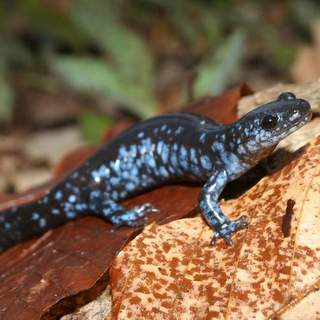By MAX COPELAND
Capital News Service
LANSING – It’s a chilly night in Marquette. About 40 degrees and rainy. But that’s not stopping dozens of people from gathering on a short stretch of road in Presque Isle Park. Because after a long, cold winter, blue-spotted salamanders are on the move.
Hundreds of salamanders are emerging from their wintertime burrows and migrating to the only nearby wetland to mate.
Ricky Rietjens is one of the dozens of people who came to see it firsthand.
“It’s magical,” Rietjens said. “You don’t see stuff like this, this is once in a lifetime stuff.”
The salamanders are about 4 inches long. They have shiny, dark gray skin and are covered in blue spots.

Department of Natural Resources.
Blue-spotted salamander.The Department of Natural Resources says the blue-spotted salamander is “quite common in woodlands, and seems to be tolerant of human habitat disturbance and fragmentation.”
On a typical day, you might be lucky enough to see just one of them, but when conditions are right in early spring, hundreds can be seen making their way across the narrow, asphalt road.
When they’re really trucking, the salamanders swivel their hips from side to side, but they can’t do that for long. They’ll stop and rest right in the middle of the road.
Which can leave them vulnerable.
“They’re not the hardest things to hit and they’re sort of not very obvious if you’re driving your car,” said Jill Leonard, a biology professor at Northern Michigan University.
A few years ago, one of her students counted at least 400 salamanders smushed by cars driving on that park road. So, he came up with a solution.
He asked city officials to close the road at night during the migration period.
Initially there was some pushback from people who liked to drive to the beach to watch the sun set over Lake Superior.
But now the community has rallied around the little amphibians. It even came up with Salamander Days — a citywide celebration with nature walks and salamander-inspired artwork.
Alex Wilson came out to witness the spring migration. Even though he’s on foot, he still has to be careful not to tread on one.
“I’m a little afraid to move around actually because this one is creeping up behind me right now,” Wilson said.
This year, NMU is asking people to count how many salamanders they see — to get a better estimate of how many there are.
Leonard says this population isn’t endangered but they’re an important part of the ecosystem to protect.
“I look at this as an effort to preserve a healthy population instead of repair a broken one,” she said.
Max Copeland reports for Interlochen Public Radio, which partners on environmental coverage with Great Lakes Echo and Capital News Service.